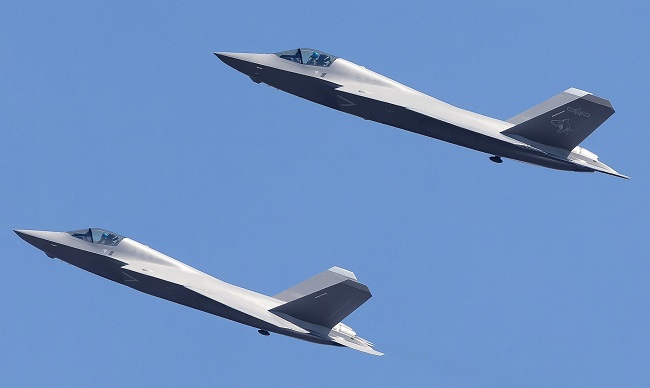
A recent photo, probably posted on the Chinese website Weibo, shows two 5th generation J-35 fighter jets with visible construction numbers (0011 and 0012), suggesting that China may have started low-rate initial production (LRIP) of this aircraft, bringing it closer to operational status.
This hypothesis is reinforced by the presence of the Chinese national symbol and a shark emblem on the tail of the 2 aircraft, typically found on operational fighter jets of the People's Liberation Army Navy (PLAN), such as the J-15. In addition, behind the canopy, on the fuselage, there is an inscription in Chinese characters meaning ‘Chinese Navy’.
The J-35 is China's second 5th generation multi-role fighter (after the J-20), produced by Shenyang. The jet is based on the FC-31, a prototype fighter developed by the company with the aim of attracting potential foreign customers. The FC-31 made its first appearance during the 2012 Zhuhai Airshow, and in 2015 it was presented for the first time outside China at the Dubai Airshow. Starting in 2018, after a series of improvements to the prototype, including the replacement of the RD-93 engines with WS-13E engines, the PLA showed interest in the aircraft.
In June 2020, the development of the naval version of the FC-31, the J-35, was announced. It made its first flight in October 2021 and is expected to make its first official public appearance on September 3, 2025, at an event organized to commemorate the 80th anniversary of Japan's defeat in World War II.
The J-35 is equipped with folding wings, reinforced landing gear, and a launch bar, and is designed to operate on Type 003 aircraft carriers. It would appear that China has already tested the fighter on the FUJIAN aircraft carrier, which is still under construction but will be the first in the Chinese fleet to be equipped with a CATOBAR system, which allows the fighter to take off using a catapult and land with the aid of arresting wires.
The aircraft features a stealth design and is equipped with AESA radar, probably the KLJ-7A also found on the FC-31 prototype, and with a distributed sensor system (DAS) and infrared tracking system (IRST). An electro-optical targeting system (EOTS) is located under the nose of the fighter. The canopy design is reminiscent of the F-35, with a one-piece canopy that opens at the front and is curved inward.
The jet should be able to carry up to six air-to-air missiles, including PL-10, PL-15, and PL-21, and 12 LS-6, four 500-kg bombs, or four air-to-ground missiles. The aircraft's configuration may vary depending on specific missions.
In addition to the naval version, Shenyang has also developed a conventional version of the J-35, which made its first flight on September 23, 2023, and is currently in service with the Chinese Air Force.
Although the precise differences between the J-35 and the J-35A are not clear yet, images that have emerged suggest that the 2 aircraft have different engines. While the J-35A uses the WS-19 engine, the J-35 may use the WS-21 engine (an improved version of the WS-13), as suggested by the serrated and clearer exhaust nozzles. Both aircraft are equipped with a small rudder.
The alleged transition of the J-35 from the prototype stage to mass production demonstrates the speed with which China is developing its military capabilities, especially in the field of naval aviation.
The Chinese fighter could be a viable alternative for countries that do not have access to US and European military capabilities, such as Pakistan, which in 2024 approved the purchase of 40 J-35, although Pakistani Defense Minister Khawaja Asif has denied that China will supply the aircraft to Pakistan by 2026. If the deal goes through, Pakistan would be the first foreign customer for the J-35.
The J-35 therefore represents a major step forward for China, not only in terms of enhancing the operational capabilities of its armed forces, but also because it could increase the global influence of the Chinese defense industry. The possibility of the aircraft being exported as a more affordable alternative to US fighter jets could in fact consolidate China's geopolitical position in Asia, expanding its influence in the region and increasing its competitiveness in the international defense market.








.png)
